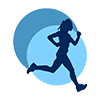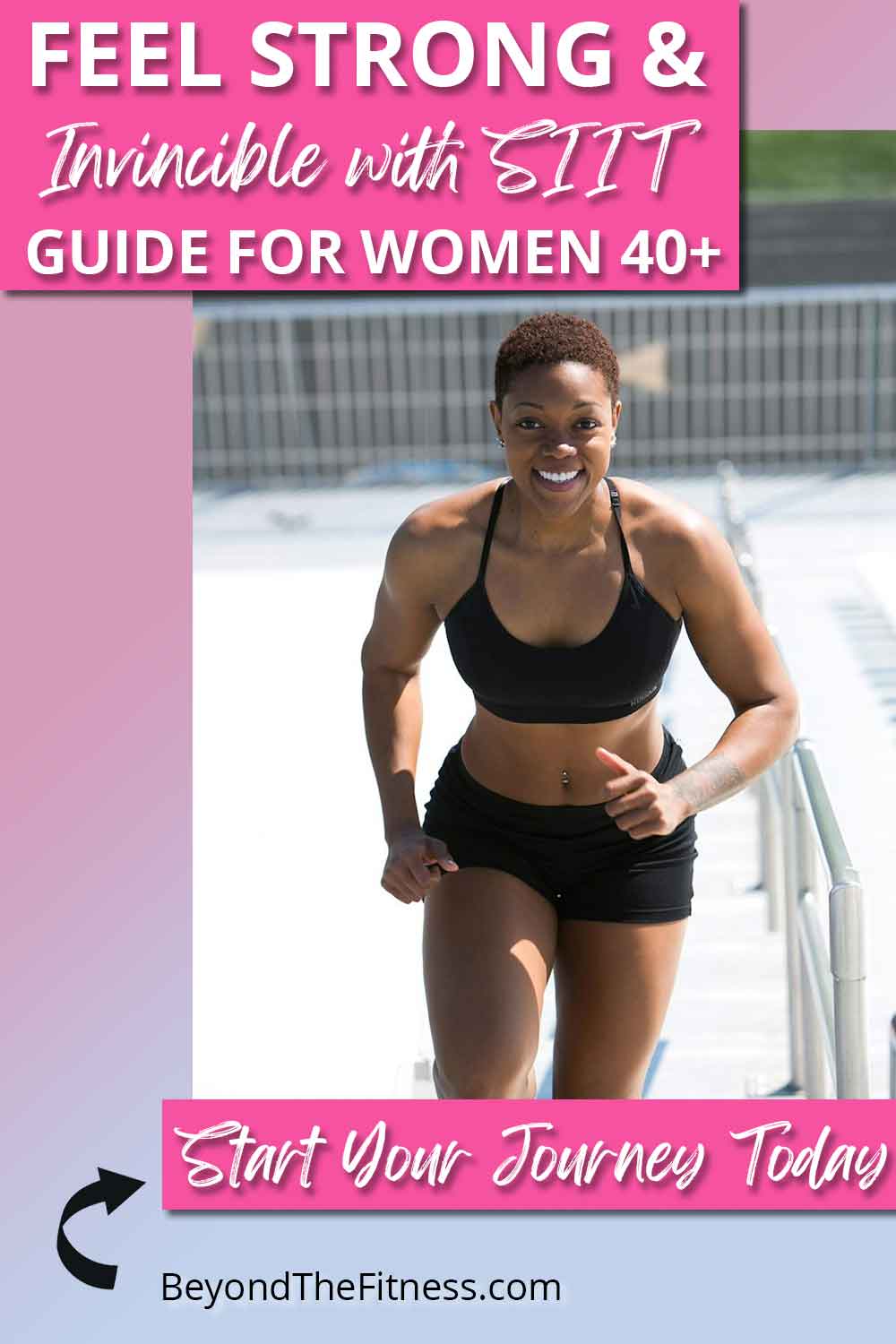If you’ve been looking for a fitness workout for women that combines cardio and strength training into one powerful routine, let me introduce you to SIIT—Strength-Integrated Interval Training. It’s an amazing way to boost energy, build muscle, and burn calories, especially for women over 40. I’ve learned how this workout can be a game-changer for anyone wanting to stay strong, healthy, and fit as they age.
What is SIIT?
SIIT stands for Strength-Integrated Interval Training, and it’s a type of workout that combines short bursts of intense effort with exercises that focus on building strength. It’s similar to HIIT (High-Intensity Interval Training), but it adds weights and resistance exercises to make it even more effective.
The great thing about SIIT is that it works on multiple parts of your body at the same time. Not only do you burn fat and improve heart health, but you also build lean muscle, which helps your metabolism. For women over 40, this is especially important because our bodies naturally lose muscle as we age.
Why Women Over 40 Should Try SIIT
Once you hit 40, you might notice some changes in your body. It’s not just about wrinkles or gray hair—it’s about how your metabolism slows down, how your bones might feel weaker, or how your energy levels drop. That’s why finding the right workout is so important.
SIIT helps in these ways:
- Builds Muscle: As we age, we lose muscle mass. SIIT helps keep your muscles strong and toned.
- Burns More Calories: Combining strength with intervals means you burn calories even after your workout is done.
- Protects Your Bones: Weight-bearing exercises improve bone density, lowering the risk of osteoporosis.
- Improves Heart Health: The cardio part of SIIT strengthens your heart and helps with blood circulation.
- Saves Time: Most SIIT workouts can be done in 20-30 minutes, making it easy to fit into a busy day.
How to Get Started with SIIT
Starting a new workout routine can feel overwhelming, but SIIT is simple once you know the basics. Here’s how I usually plan my SIIT sessions:
- Warm-Up: Begin with 5-10 minutes of light cardio, like walking, jogging in place, or dynamic stretches.
- Interval Rounds: Alternate between strength exercises and cardio bursts. For example, do squats for 30 seconds, then jump rope for 30 seconds. Repeat this cycle.
- Cool-Down: Spend a few minutes stretching your muscles to improve flexibility and prevent soreness.
A Sample SIIT Workout
Here’s a simple workout you can try at home or at the gym:
- Warm-Up (5 minutes): March in place, do arm circles, or try light jogging.
- Round 1:
- 30 seconds of bodyweight squats
- 30 seconds of jumping jacks
- Rest for 15 seconds
- Round 2:
- 30 seconds of push-ups (modify on your knees if needed)
- 30 seconds of high knees
- Rest for 15 seconds
- Round 3:
- 30 seconds of lunges
- 30 seconds of burpees (or step-back burpees for a low-impact version)
- Rest for 15 seconds
- Cool-Down (5 minutes): Stretch your legs, arms, and back.
Repeat the rounds 2-3 times if you have more time and energy!
Tips for Success with SIIT
When I first started SIIT, I found these tips helpful to stay consistent and see results:
- Focus on Form: Always prioritize proper form to avoid injuries. Start with lighter weights and progress gradually.
- Listen to Your Body: If something doesn’t feel right, modify the move or take a break.
- Stay Consistent: Aim for 3-4 SIIT workouts per week for the best results.
- Pair with Healthy Eating: Eating whole, nutrient-rich foods will fuel your workouts and recovery.
Equipment You Might Need
The great thing about SIIT is that you don’t need a lot of fancy gear. I love that I can do it at home with just a few items, like:
- Dumbbells or resistance bands
- A yoga mat for comfort
- A sturdy chair or bench for step-ups or tricep dips
If you’re just starting out, bodyweight exercises work perfectly fine, too!
Benefits of SIIT for Women’s Fitness Goals
One of my favorite things about SIIT is how flexible it is. You can make it as challenging or as simple as you need. Whether your goal is weight loss, building strength, or improving endurance, SIIT can help you get there.
For example:
- Weight Loss: The high-intensity intervals torch calories, while strength training builds muscle that boosts metabolism.
- Toning and Shaping: Exercises like squats, lunges, and push-ups target all the major muscle groups.
- Better Endurance: Cardio bursts keep your heart and lungs in top shape.
SIIT vs. Other Workouts
You might be wondering, “Why choose SIIT over other workouts?” Here’s what makes it stand out:
- Compared to Cardio: SIIT burns more calories in less time because of the strength component.
- Compared to Strength Training Alone: Adding intervals keeps your heart rate up, making it a more effective calorie-burner.
- Compared to HIIT: SIIT focuses more on building muscle, which is especially important for women over 40.
Staying Motivated
Sticking to any workout routine takes effort, but here’s what helps me stay on track with SIIT:
- Set Small Goals: Instead of aiming for perfection, focus on small wins, like completing three workouts in a week.
- Find a Buddy: Working out with a friend makes it more fun and keeps you accountable.
- Mix It Up: Change your exercises regularly to keep things fresh and exciting.
Nutrition Tips to Support SIIT
What you eat plays a big role in how effective your workouts are. I like to focus on:
- Protein: Helps repair and build muscles. Think eggs, chicken, tofu, or Greek yogurt.
- Healthy Carbs: Fuels your energy for those intense intervals. Whole grains, fruits, and veggies are great options.
- Healthy Fats: Keeps your body balanced. Try avocados, nuts, or olive oil.
- Hydration: Drinking plenty of water before, during, and after workouts keeps me feeling strong.
Final Thoughts
SIIT is a fantastic fitness workout for women over 40 who want to build strength, boost energy, and stay healthy. By combining strength training and intervals, you get the best of both worlds in a workout that fits into your busy life. Whether you’re a beginner or a fitness enthusiast, this workout can work for you. All you need is some motivation and a little time to get started!
Customizing SIIT for Different Fitness Levels
One of the best things about SIIT is how flexible it can be. No matter where you are on your fitness journey, you can modify the workout to match your abilities. When I first started, I was nervous about pushing myself too hard, but I quickly learned that SIIT is all about working at your pace.
Beginner-Friendly SIIT
If you’re new to fitness or haven’t exercised in a while, start with low-impact moves and lighter weights. The goal is to get comfortable with the movements while building strength and endurance.
You Might Be Interested In: Learning more about The Complete Smoothie Detox & Weight Loss Program
- Replace high-impact moves like jumping jacks with step touches.
- Use your body weight instead of dumbbells for strength exercises.
- Increase rest times between intervals to 20-30 seconds if needed.
Here’s an example of a beginner round:
- Bodyweight Squats (30 seconds)
- Step Touches (30 seconds)
- Modified Push-Ups (30 seconds)
- March in Place (30 seconds)
- Rest for 20-30 seconds and repeat the round.
Advanced SIIT
If you’re already active and looking to take your fitness to the next level, you can make SIIT more challenging by adding:
- Heavier weights or resistance bands.
- Plyometric moves like jump squats or box jumps.
- Shorter rest periods to increase intensity.
Here’s an advanced round you can try:
- Dumbbell Deadlifts (30 seconds)
- Burpees with a Push-Up (30 seconds)
- Weighted Step-Ups (30 seconds)
- Mountain Climbers (30 seconds)
- Rest for 10-15 seconds and repeat the round.
The Role of Recovery in SIIT
Recovery is just as important as the workout itself, especially for women over 40. As we age, our bodies take a little longer to repair and rebuild after exercise, so I always make sure to prioritize recovery.
Active Recovery Days
On days when you’re not doing SIIT, try light activities like walking, yoga, or stretching. These help your body recover without putting too much strain on your muscles.
Post-Workout Recovery Tips
- Stretching: Spend extra time stretching after your SIIT session. Focus on areas like your hamstrings, quads, shoulders, and lower back.
- Foam Rolling: A foam roller can help release tight muscles and improve blood flow.
- Hydration and Nutrition: Drinking plenty of water and eating a balanced meal with protein and carbs after your workout helps with muscle recovery.
- Restful Sleep: Sleep is when your body does most of its repair work, so aim for 7-9 hours of quality sleep each night.
SIIT for Specific Goals
Whether you’re looking to lose weight, improve endurance, or simply feel stronger, SIIT can be tailored to help you achieve your goals.
Weight Loss
SIIT is incredibly effective for burning calories and fat because it keeps your heart rate elevated throughout the workout. Plus, the strength training component builds muscle, which helps you burn more calories even when you’re resting.
To maximize weight loss, focus on compound movements like squats, lunges, and deadlifts. These exercises target multiple muscle groups and burn more calories in less time.
Strength Building
If your main goal is to build strength, incorporate heavier weights and slower, controlled movements into your SIIT routine. For example, you can do:
- Goblet Squats: Hold a dumbbell close to your chest while squatting.
- Bent-Over Rows: Use dumbbells to strengthen your back and arms.
- Overhead Presses: These target your shoulders and core.
Improving Mobility and Flexibility
SIIT doesn’t just build strength and endurance—it can also improve your mobility and flexibility when done correctly. Include exercises like:
- Side Lunges: Open up your hips and improve lateral movement.
- Plank Variations: Strengthen your core while promoting stability.
- Dynamic Stretches: Moves like leg swings or arm circles are great for warming up and improving range of motion.
Overcoming Common Challenges with SIIT
Like any workout, SIIT comes with its challenges, but they’re all manageable with the right mindset and strategies.
Limited Time
One of the reasons I love SIIT is that it’s designed to be quick and efficient. If you’re short on time, even a 15-minute session can be effective. Focus on quality over quantity by giving your best effort during each interval.
Lack of Motivation
We all have days when we don’t feel like working out. To stay motivated:
- Create a playlist of your favorite upbeat songs.
- Set small, achievable goals, like completing two SIIT sessions this week.
- Keep a journal to track your progress and celebrate your wins.
Joint Pain or Injuries
If you have joint pain or a past injury, modify the exercises to suit your needs. For example:
- Replace high-impact moves with low-impact alternatives.
- Use lighter weights or resistance bands.
- Focus on proper form to reduce strain on your joints.
The Importance of a Balanced Routine
While SIIT is an amazing workout, I always make sure to balance it with other forms of exercise to keep my routine well-rounded. This includes:
- Cardio: Activities like walking, cycling, or swimming improve heart health and endurance.
- Strength Training: Focused strength workouts complement SIIT by allowing you to lift heavier and target specific muscle groups.
- Flexibility Work: Yoga or Pilates helps improve posture, balance, and overall flexibility.
Tracking Your Progress
When I started doing SIIT, I realized how important it is to track my progress. It keeps me motivated and helps me see how far I’ve come. Here are some simple ways to do it:
- Keep a Workout Log: Write down your exercises, weights, and how many rounds you complete.
- Take Photos: Progress photos can be a great way to see changes in your body over time.
- Notice Non-Scale Victories: Pay attention to how your clothes fit, how much energy you have, or how strong you feel during workouts.
SIIT for Women with Busy Schedules
Life can get hectic, especially if you’re balancing work, family, and personal time. That’s why I love how flexible SIIT is—you can adjust the length and intensity of your workout to fit your schedule.
Quick 10-Minute SIIT Routine
Even on the busiest days, you can fit in a quick 10-minute workout. Here’s an example:
- Bodyweight Squats (30 seconds)
- Push-Ups (30 seconds)
- Mountain Climbers (30 seconds)
- Jumping Jacks (30 seconds)
- Repeat twice for a 10-minute burn.
How to Stay Consistent with SIIT
Consistency is key to seeing results, and I’ve found that these strategies help me stick to my SIIT routine:
- Schedule Your Workouts: Treat your workouts like appointments and block off time on your calendar.
- Find a Workout Buddy: Exercising with a friend keeps you accountable and makes it more fun.
- Set Up a Home Gym: Having basic equipment at home makes it easier to stay on track.
By adding these additional insights, strategies, and routines, this extended article provides even more value to women over 40 exploring SIIT. It’s designed to inspire confidence and help readers incorporate this transformative workout style into their lives!







